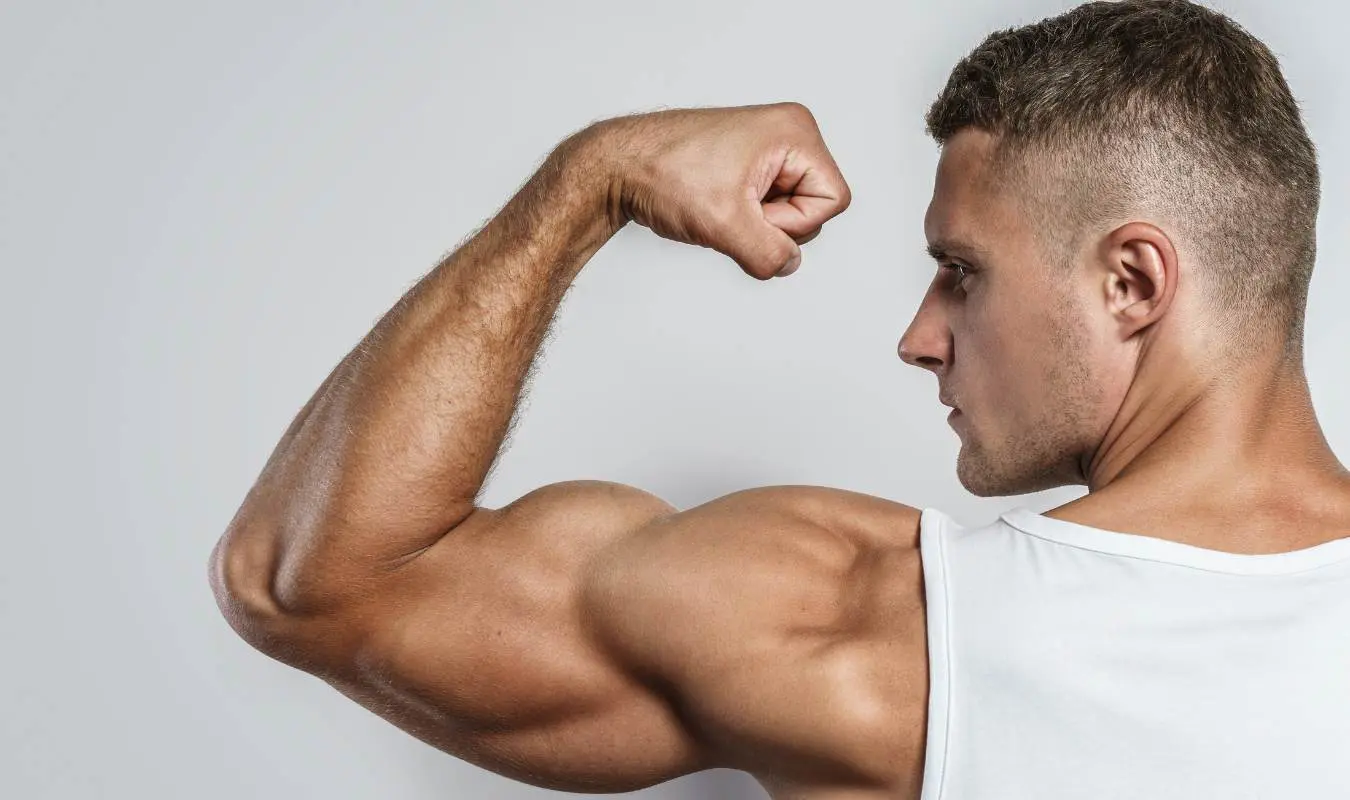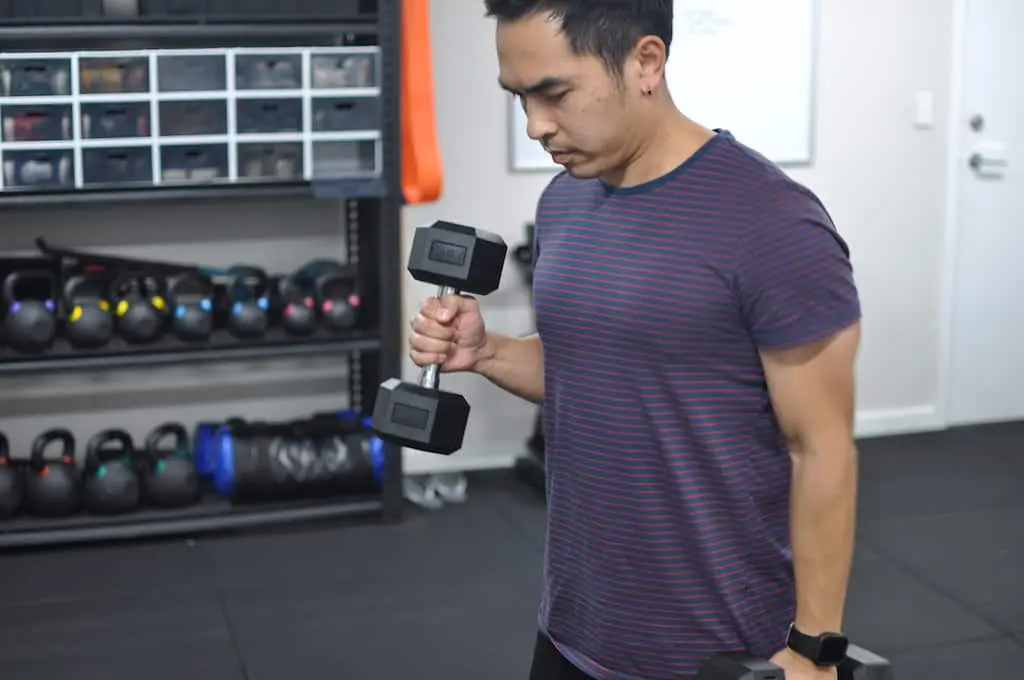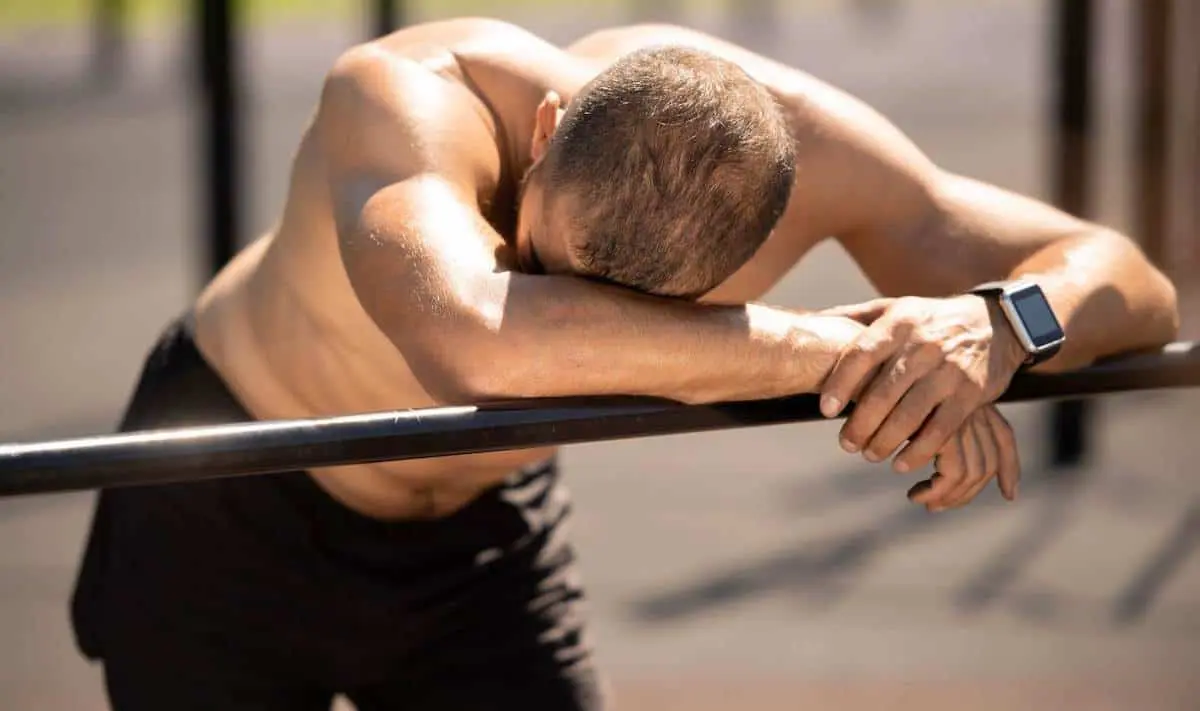
The best online fitness resource you'll ever need. We filter out the BS to ensure you meet your health and fitness goals!

The best online fitness resource you'll ever need. We filter out the BS to ensure you meet your health and fitness goals!

Quite possibly the single visual denominator for a muscular, jacked physique is a pair of muscular arms. Deep and wide biceps with peak strains short sleeve shirts. Triceps pronounced when relaxed with telltale horseshoe when flexed. Golf ball bulge at the elbow. Thick forearms tracked with visible vasculature.
Do I have your attention yet? Good, because in this article, I’m going to introduce you to our Ultimate Big Arms Workout Routine that will help you achieve those impressive biceps, triceps, and forearms.
For balance, you need V-taper from shoulder to waist, chest thickness, high firm hips, developed thigh sweep…and all the other stuff in between.
However…
Nothing tells the world that you work out like a set of guns.
A desire for “better” arms is universal.
A young aspiring woman bodybuilder recently approached me in the gym, asking about arm development. So having aesthetically and appropriately jacked arms spans sexes. (She already has pretty nice guns, BTW.)
Get ready for Summer and short sleeves… or no sleeves!
Jump to the workout routine now!
Alternatively, you can download the free PDF version of the routine using the link below:
| Program style | Resistance training with gym machines |
| Workout duration | 1 hours |
| Scheduling | 1 day a week, can incorporate into other programs |
| Goal | Build bigger arms |
| Level | Beginners to advanced |
| Target Gender | Male and Female |
Yes.
“Wait” you say. “I work out. I’ve already got big arms.”
Maybe so.
But maybe they could be even better.
This program can be used by anyone wanting larger, muscular arms…and right now, I can think of very few who don’t.
I’ve crafted this program from my own 40-plus years of trial, error, and success…
…and researched the routines of the legit pros (including zero steroid-taking poser influencers)…
What you’ll find here is a workout that can stand on its own, or be added to pretty much any workout routine you’re doing today in the weight room.
This Big Arms Workout requires a fully-equipped gym. It’s possible to substitute dumbbells and barbells for some of the exercises. I don’t get into that here.
Machines will let you focus in on your biceps and triceps and remove variables that can rob those muscles of the attention they deserve.
Of particular importance are triceps machines, especially seated.
I found some tasty research on the effect that shoulder elevation has on which head of the triceps is most involved (Kholinne E, et al).
It showed that how high you raise your arm does indeed affect whether the long, medial, or lateral triceps head is able to exert the most force.
Admittedly, the study involves a small cohort; however, the way they structured the study made a lot of sense, and their conclusion about the long head correlates to what you’d expect out of a bi-articular muscle.
Since the long head crosses the shoulder and the elbow, you’d expect that keeping it by your side would make it work better…and that’s what they study showed.
Here’s an excerpt:
Each head of the TB has a different pattern of force and activity during different shoulder elevations. At low shoulder elevations, the long head of the TB has the major role in elbow extension. While in higher shoulder elevation angles, the medial head takes over as the major muscle.
So…
Attacking the triceps at different shoulder elevations is baked into this Big Arms routine – and for that, I’d recommend a full gym.
A good, solid palms-up curl and a hammer curl variation should be all you need to grow your biceps.
Palms Up curls put the biceps brachii (upper arm) in position to build size and peak.

Hammer Curls involve the brachioradialis and therefore are helpful to build thickness around the elbow.

If you’d like to use preacher curls for your palms up variations, go ahead. Unless I’m there in person to coach someone (including myself), preacher curls make me nervous.
Very few know how to do them in a way that prevents injury, and they are notorious for biceps tendon injuries, which can be both crippling and disfiguring. Again, the juice isn’t worth the squeeze.
I’ve added some forearm work as an option for those who feel they need it. Frankly, if you’re killing the biceps exercises, the forearms will come along too.
Do Grip Trainers Help Grow Forearms?
No.
Next question.
Can You Bias Long or Short Biceps Heads with Arm Position?
Again, no.
There is a reason why. Both long and short heads of the biceps muscle insert at the same place on the forearm, so rotating your shoulder in or out makes no difference other than comfort.

Certain shoulder conditions may dictate which arm position is most comfortable, since the long head of the biceps crosses the head of the upper arm bone (humerus).
If the shoulders are rotated forward (rounded shoulders) – as is the case with many people today due to poor posture – it can put the long head tendon under frictional stress and lead to inflammation there.
This Big Arms Routine is designed to complement your existing workout regimen. You can seamlessly incorporate these arm-focused exercises to boost your arm development without disrupting your overall training balance.
While it can be done individually, it truly shines when integrated into another routine of your choice.
But where in your current routine should you do this workout? Valid question.
I’ve written the program as an Arm Day, so it will work best as part of a Bro Split.
LIfters who follow a Push Pull Leg Split can separate biceps exercises into Pull Day, and Triceps into Push Day.
You Upper-Lower folks can put this in either the Upper or Lower Day. Why? Aren’t arms Upper?
Indeed they are, obviously. Put biceps and triceps with Lower body due to workload and fatigue. Arms are a nice balance to Leg work.
If you’re following a Full Body workout plan, select 1 biceps and 1 triceps exercise from the Big Arms plan for each workout.
If you’re following a different type of workout plan, and still want guidance on where to incorporate this Big Arms Workout, drop us a line in the Comments section.
Regardless, incorporating this Arm Routine into your current workout routine ensures you maximize your gains while maintaining a comprehensive fitness regimen.
I wrote this Big Arms workout to be done once a week. Frequency greater than that will lead to overtraining for anyone training natural.
Each exercise is performed for 4 sets: 1 is a warm-up for that particular exercise, and the next 3 are “working sets”. I debated reducing working sets from 3 to 2; however, I’ve found that most readers will not take a low volume plan seriously, so I caved and added the 3rd working set.
The best-of-the-best resistance training minds today have backed away from high volume routines. Supersets, drop sets, lengthened partial reps…they’re just not into those any more.
There are very accomplished lifters out there who use these techniques in unique situations and for very specific reasons. The Big Arms program you’ll find here is a good general-application workout that I predict you’ll like and see results from.
Check out the Application Notes below for specifics.
| Exercise | Set 1 | Set 2 | Set 3 | Set 4 |
|---|---|---|---|---|
| Biceps Curls, Palms Up | 15-20 | 6-8 | 6-8 | 4-6 |
| Hammer Curls | 15-20 | 6-8 | 6-8 | 4-6 |
| (Optional) Forearm Curls, Palm Up | 8-10 | 8-10 |
| Exercise | Set 1 | Set 2 | Set 3 | Set 4 |
|---|---|---|---|---|
| Overhead Triceps Extensions | 15-20 | 6-8 | 6-8 | 4-6 |
| Seated Double Triceps Extension Machine | 15-20 | 6-8 | 6-8 | 4-6 |
| Cable Triceps Extensions (Elbows low as possible) | 15-20 | 6-8 | 6-8 | 4-6 |

Of all the application principles almost everyone agrees upon, this might be the most agreeable.
The concept is simple: when a load gets easy at a given rep range, raise the weight or reps.
For hypertrophy routines like this one, raise the weight.
Aim to bust the 6-rep barrier. The great Paul Carter turned me onto this metric, and it’s made a difference in the results I see personally. When I can do a 6th rep at a given weight, the weight goes up in the next set, or next workout.

Whoa. Much debate. Train to failure every set? Leave some in the tank?
For this program, aim for 1 rep in reserve for sets 2 and 3 (since the 1st set is your warm-up for that exercise). Then an all-out 0 RIR for the final gut-busting set.
Never ever use crappy form on any of your sets, and least of all, that last one.
Grinding out your reps with good form elicits the muscular tension necessary for growth. Press or pull against the heaviest weight possible as fast as possible. The weight won’t be moving fast but out of view your muscle fibers will be doing what they need to do to grow.
Now…
There will be times when you may need to take your foot off the gas so to speak and use 1 to 2 RIR for an entire workout. I can’t tell you when…only you can know that. However, in general, if your workouts are sucking and your progress has stalled, it may be an indicator you need to change RIR.
No need to worry about speed of concentric or eccentric contraction. Go for rhythm. Pump that iron.
Avoid ballistics like you would poisonous creatures.

Rest a minute or two between warm-up sets and the working sets to follow. Your “working” sets will require longer rest times. Aim for three minutes between sets. Spend that time analyzing the set you just did. Ask:
Then, visualize your next set.
Leave your phone in your locker or bag.
Download our Big Arms Workout Routine PDF below:
We write custom programs. If you have specific physique goals–such as “I’d like wider shoulders”, or “I’d like more ‘V’ in my back”–we can write one for you. Reply in the Comments or simply contact us and we’ll get back in touch. First come, first served.